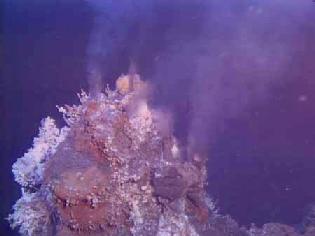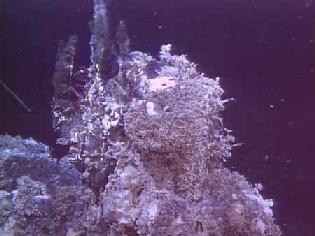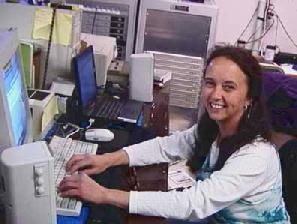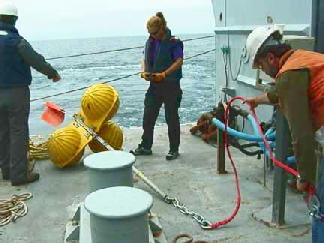WHAT'S NEW:
BACKGROUND:
Mission
Project Description
Cruise Plans:
Participants
Technology (ROV, ships, etc.)
Future Plans
Results:
1998 NeMO Cruise
Axial 1998 "Eruption"
Logbook
July 12, 1999
Contents:
- News from Thompson
- Participant Perspective
- Logbook from Teacher at Sea
- Question/Answer from shore to sea
Thompson Science Report
Science Report - Monday, July 12
Ships Location: 45 56.1/130 00.7
  Vents of the ASHES vent field. Top: Hell Vent (fluid at 290oC; bottom: Mushroom Vent with tube worms. |
Listing of all Science News postings
Life at Sea: Participant Perspective
Susan Merle
OSU/NOAA Vents Program
 My name is Susan
Merle. I'm employed by Oregon State University as a research assistant
for the NOAA EOI Program. Almost 8 years ago I graduated from University
of Washington with a degree in Oceanography. Wow, how time flies when
youre having fun. I work in Newport,
Oregon at Hatfield Marine Science Center
with Bob Embley and
Bill Chadwick. Our
main area of study is Axial
Volcano, although from time to time I've heard that we do venture
other places
in the Pacific. I haven't seen that yet. This is my second trip out to
Axial (the site of the NeMO Observatory) where the Vents Program and
its associates have been doing time series studies for over fifteen years.
Using ROPOS we are able to collect data that allows us to observe changes
in the chemistry, biology, and - my favorite - the geology of the volcano
and its vents.
My name is Susan
Merle. I'm employed by Oregon State University as a research assistant
for the NOAA EOI Program. Almost 8 years ago I graduated from University
of Washington with a degree in Oceanography. Wow, how time flies when
youre having fun. I work in Newport,
Oregon at Hatfield Marine Science Center
with Bob Embley and
Bill Chadwick. Our
main area of study is Axial
Volcano, although from time to time I've heard that we do venture
other places
in the Pacific. I haven't seen that yet. This is my second trip out to
Axial (the site of the NeMO Observatory) where the Vents Program and
its associates have been doing time series studies for over fifteen years.
Using ROPOS we are able to collect data that allows us to observe changes
in the chemistry, biology, and - my favorite - the geology of the volcano
and its vents.
While at sea I perform several duties, the most time consuming of which is the 8 hours a day I spend navigating the sub. No, we dont actually drive the sub - just try to let the ROPOS crew and scientists know where we are on the seafloor. Paul Johnson gave you a good explanation of navigation earlier so I won't bore you with the details. Paul, Maia and myself split the day into 4 hour segments, each of us doing two 4 hours shifts per day. Bill Chadwick oversees all of our navigation endeavors. I also process the navigation after the dives, editing out bad "fixes" that can occur due to several factors (such as noise in the water, the hot water around the vents, "bounces" off features on the bottom, etc.). On a cruise like this lots of samples are collected, dive logs are kept, and instruments are deployed and recovered. My job as Bob Embley's assistant is to try to keep track of all the above and pull all that information together into a cruise report for all the scientists on board. This can be a challenge, at best. In Newport I perform many other tasks such as making maps, preparing figures for papers, posters for meetings, use GIS for database management, process bathymetry and sidescan sonar, and I'm sure theres a whole lot more I do - but right now I just can't remember it. Sort of a jack of all trades and a master of none.
The seas are kicking up tonight (predictions are for up to 40 knot winds and 17 foot seas) and reminding us that we are land creatures trying to study the processes under the sea, and just how difficult that can be at times. The wind if howling and I haven't really warmed up since we arrived almost a month ago. I love my job and my time at sea, but must admit I'm looking forward to heading back towards shore tomorrow. I hear that it is summer in Oregon, and I'm hoping to experience a bit of that before its over. Land ho!!
Listing of all Perspectives postings
Teacher At Sea Logbook
Teachers Log #22 7/12/99
 Between
dives yesterday, Jim Gendron
supervised the deployment of moorings (photo right) for Ed
Baker (the principle investigator on this project) of NOAA/PMEL in
Seattle. These moorings and the sensing equipment on them are another
way to monitor eruptive events by looking at the plumes that are associated
with them. These instruments are used around the world at many volcanically
active sites. They can be deployed for long-term use as they are doing
here at Axial, or they can be towed through selected areas for temporary
data collection.
Between
dives yesterday, Jim Gendron
supervised the deployment of moorings (photo right) for Ed
Baker (the principle investigator on this project) of NOAA/PMEL in
Seattle. These moorings and the sensing equipment on them are another
way to monitor eruptive events by looking at the plumes that are associated
with them. These instruments are used around the world at many volcanically
active sites. They can be deployed for long-term use as they are doing
here at Axial, or they can be towed through selected areas for temporary
data collection.
Hydrothermal vent plumes are fluids that are released from vents, rise in the water column and begin mixing with the surrounding sea water. The rising fluid is referred to as the buoyant plume whereas the fluid that spreads out once it reaches a specific height in the water column is the non-buoyant plume. Plumes can be studied by looking at the "signature" of the plume - the temperature, metals, and other unique elements of the plume change with the distance it travels from the actual vent site. Some elements like helium (He) can leave a "trail" in the water column not only as it rises but also as it spreads out once it becomes non-buoyant. Megaplumes are rare events. These are extremely large short-lived events, expelling incredible volumes of fluid that are associated with eruptions like that of 1998. The thermochemical signature of this type of plume can be mapped for many miles through the ocean. Just what the impact is of these megaplume events on the oceans overall thermochemical budget is just one of the many questions being investigated.
The set up for the deployment of these moorings includes an anchor and floatation at opposite ends. Between them, the data collecting sensors and a release mechanism are positioned. Just above the anchor sits an acoustic release. These make it possible for a ship-based retrieval instead of depending on an ROV to cut them loose. Along the 300 meters of line are temperature and nephelometer recorders. The placement of these instruments is based on scientific prediction as to where in the water column hydrothermal non-buoyant plumes will be. The temperature probes are designed to record the water temperature at a specific time interval each day for a year. Also included are combinations of a temperature and pressure sensor along with a nephelometer. The nephelometer sends out a beam of light into the water. The amount of reflected light that it receives back enables scientists to determine how much particulate matter is in the water from the hydrothermal vents. At the beginning of our cruise, the Wecoma, another ship out of Oregon State University, was on site deploying similar moorings around the outer perimeter of Axial.
This morning we completed our first dive of this cruise at Ashes vent field. This was a remarkable site with one vent having 310 degree Celsius fluid pouring out of it! By observing the rapid nature of its escape from the vent as well as shimmering nature, one could almost "see" the heat it contained. Currently we are back down at Ashes for our last dive of the cruise!
Bye for now.
Logbook of all Teacher At Sea postings
Questions & Answers
(oar.pmel.vents.webmaster@noaa.gov)